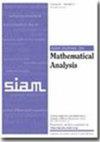带声波或非声波边界的半导体流体力学模型亚声速稳定状态的弛豫时间限制
IF 1.9
2区 数学
Q1 MATHEMATICS, APPLIED
引用次数: 0
摘要
SIAM 数学分析期刊》,第 56 卷第 3 期,第 3452-3477 页,2024 年 6 月。 摘要本文涉及带有声波边界或非声波边界的欧拉-泊松方程形式的半导体一维稳定流体力学模型的弛豫时间限制。声波边界是最关键和最困难的情况,因为在边界处会出现退化并形成边界层。为了避免二阶导数的退化,我们在技术上对工作方程引入了可逆变换。由于这里使用的变换是严格递增的,这就保证了剩余的一阶退化成为一个好的项。这样,我们就能有效克服退化效应。当弛豫时间为[math]时,我们首先展示了近似解在[math]规范下以[math]阶对其渐近剖面的强收敛性。当[math]时,由于边界数据互不相等,会出现边界层,我们根据边界数据的不同情况,进一步推导出[math]或[math]阶[math]规范下近似解背景剖面的均匀误差估计。与以往研究采用的方法不同,我们提出了一些全新的渐近极限分析技术,成功地描述了边界层的宽度,几乎达到了[math]提供的[math]阶。这些原创方法发展并改进了现有研究。最后,我们进行了一些数值模拟,证实了我们的理论研究,特别是边界层的出现。本文章由计算机程序翻译,如有差异,请以英文原文为准。
Relaxation Time Limits of Subsonic Steady States for Hydrodynamic Model of Semiconductors with Sonic or Nonsonic Boundary
SIAM Journal on Mathematical Analysis, Volume 56, Issue 3, Page 3452-3477, June 2024.
Abstract. This paper concerns the relaxation time limits for the one-dimensional steady hydrodynamic model of semiconductors in the form of Euler–Poisson equations with sonic or nonsonic boundary. The sonic boundary is the critical and difficult case because of the degeneracy at the boundary and the formation of the boundary layers. In order to avoid the degeneracy of the second order derivatives, we technically introduce an invertible transform to the working equation. This guarantees that the remaining one order degeneracy becomes a good term since the transform used here is strictly increasing. Then we efficiently overcome the degenerate effect. When the relaxation time [math], we first show the strong convergence of the approximate solutions to their asymptotic profiles in [math] norm with the order [math]. When [math], the boundary layer appears because the boundary data are not equal to each other, and we further derive the uniform error estimates of the approximate solutions to their background profiles in [math] norm with the order [math] or [math] according to the different cases of boundary data. Unlike the methods adopted in the previous studies, we propose some altogether new techniques of the asymptotic limit analysis to successfully describe the width of the boundary layer, which is almost the order [math] provided [math]. These original approaches develop and improve the existing studies. Finally, some numerical simulations are carried out, which confirm our theoretical study, in particular, the appearance of boundary layers.
Abstract. This paper concerns the relaxation time limits for the one-dimensional steady hydrodynamic model of semiconductors in the form of Euler–Poisson equations with sonic or nonsonic boundary. The sonic boundary is the critical and difficult case because of the degeneracy at the boundary and the formation of the boundary layers. In order to avoid the degeneracy of the second order derivatives, we technically introduce an invertible transform to the working equation. This guarantees that the remaining one order degeneracy becomes a good term since the transform used here is strictly increasing. Then we efficiently overcome the degenerate effect. When the relaxation time [math], we first show the strong convergence of the approximate solutions to their asymptotic profiles in [math] norm with the order [math]. When [math], the boundary layer appears because the boundary data are not equal to each other, and we further derive the uniform error estimates of the approximate solutions to their background profiles in [math] norm with the order [math] or [math] according to the different cases of boundary data. Unlike the methods adopted in the previous studies, we propose some altogether new techniques of the asymptotic limit analysis to successfully describe the width of the boundary layer, which is almost the order [math] provided [math]. These original approaches develop and improve the existing studies. Finally, some numerical simulations are carried out, which confirm our theoretical study, in particular, the appearance of boundary layers.
求助全文
通过发布文献求助,成功后即可免费获取论文全文。
去求助
来源期刊
CiteScore
3.30
自引率
5.00%
发文量
175
审稿时长
12 months
期刊介绍:
SIAM Journal on Mathematical Analysis (SIMA) features research articles of the highest quality employing innovative analytical techniques to treat problems in the natural sciences. Every paper has content that is primarily analytical and that employs mathematical methods in such areas as partial differential equations, the calculus of variations, functional analysis, approximation theory, harmonic or wavelet analysis, or dynamical systems. Additionally, every paper relates to a model for natural phenomena in such areas as fluid mechanics, materials science, quantum mechanics, biology, mathematical physics, or to the computational analysis of such phenomena.
Submission of a manuscript to a SIAM journal is representation by the author that the manuscript has not been published or submitted simultaneously for publication elsewhere.
Typical papers for SIMA do not exceed 35 journal pages. Substantial deviations from this page limit require that the referees, editor, and editor-in-chief be convinced that the increased length is both required by the subject matter and justified by the quality of the paper.

 求助内容:
求助内容: 应助结果提醒方式:
应助结果提醒方式:


